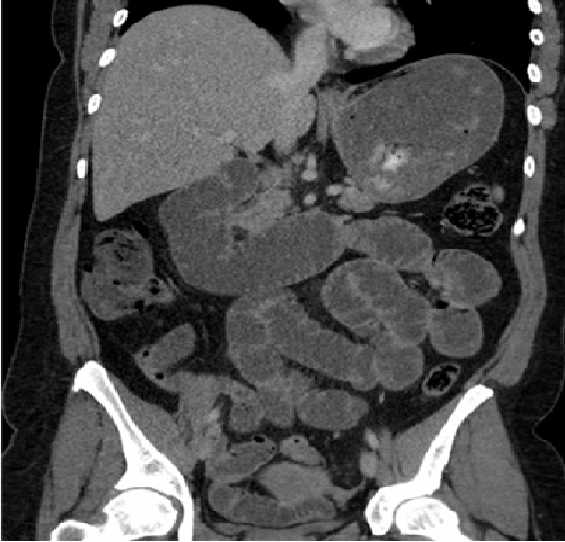Case Presentation: A 40-year-old female with morbid obesity, methamphetamine dependence, and tobacco use disorder presented with the one-day onset of diffuse and severe abdominal pain. A review of the systems was positive for nausea, vomiting, inability to tolerate food by mouth, constipation, and diaphoresis but she denied fever, diarrhea, or other related symptoms. Patient-reported using amphetamines in higher amounts for the last two days before hospitalization. Vital signs on presentation with tachycardiac at 140 bpm, tachypneic at 32 bpm, afebrile, normotensive, and normal oxygen saturations Physical exam was significant for diffusely tender, distended, and with decreased bowel sounds. Initial labs showed leukocytosis 28.8K/ul; Basic metabolic panel revealed acute kidney injury with a creatinine of 1.1 mg/dL (baseline of 0.7 mg/dL). The liver function panel was unremarkable. Lactate was within normal limits at 1.9 mmol/L. A urine drug screen was positive for amphetamines. Hepatitis C and HIV were negative. Blood cultures showed no growth. Clostridium difficile PCR toxin was negative. EKG showed sinus tachycardia. CT of abdomen and pelvis with contrast demonstrated small bowel distention with fluid and gas with numerous dilated bowel loops reflecting ileus without discrete transition point. A diagnosis of methamphetamine-induced paralytic ileus was made. Due to lack of acute abdomen and peritoneal signs, surgery was deferred and she was managed conservatively. A nasogastric tube was inserted and placed to suction. She was started on intravenous fluids; electrolytes were optimized, and she was put on bowel rest with serial abdominal exams. The patient was initially started on intravenous antibiotics which were discontinued after two days with no growth in blood cultures. Gradually patient started to pass flatus and serial abdominal imagining showed improvement. She had a large bowel movement on day 3 of hospitalization. Her nasogastric tube was discontinued, and her diet was advanced which she tolerated well. She was discharged the following day and was counseled to refrain from using methamphetamines in the future with referral to a substance use assistance center.
Discussion: Paralytic ileus is an exceedingly rare complication of methamphetamine. It leads to the activation of the dopamine-1 and norepinephrine receptors, which results in a significant decrease in small bowel contractility by decreasing the enteric muscle tone leading to paralytic ileus. There are only two previously reported case reports in the literature, similarly to the case described in our report, the patient presented with a short history of abdominal pain, tachycardia, and abdominal signs consistent with ileus. Higher doses are associated with more displacement of monoamines and therefore more adverse effects including the higher chances of direct effects of dopamine and norepinephrine on intestinal motility. With no other obvious etiology for the ileus, we propose that the cause of the ileus was due to the ingestion of a higher-than-usual dose of methamphetamine.
Conclusions: Methamphetamines at higher doses can lead to paralytic ileus. Paralytic ileus due to methamphetamine use although extremely rare but should be in differentials while evaluating different causes of ileus.

